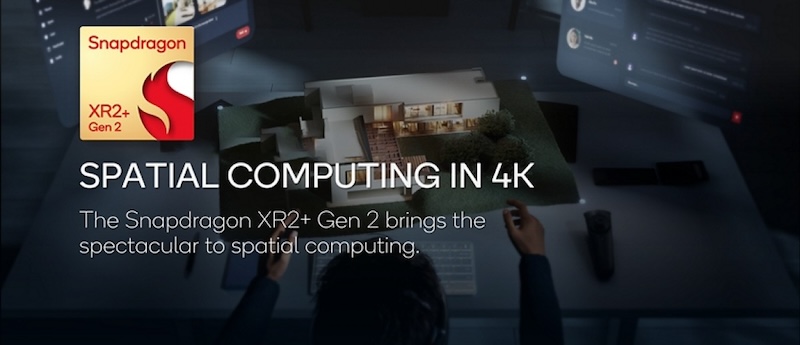Virtual and augmented reality headsets are poised to take a big leap forward in the coming years. Many tech giants like Apple, Meta, and Google are investing heavily in this emerging market, aiming to make extended reality (XR) devices smaller, lighter, more powerful and mainstream.
Qualcomm has unveiled its latest chipset to challenge Apple’s upcoming Vision Pro headset – Snapdragon XR2+ Gen 2 platform. With impressive capabilities like single-eye 4.3K resolution support and AI-powered tracking, can it give Apple a run for its money?
The Snapdragon XR2+ Gen 2 is an upgraded iteration of the XR2 Gen 2 chip used in Meta’s latest Quest 3 headset. Major highlight is its ability to drive high-resolution visuals on par with the rumored 3K per-eye resolution of Apple’s Vision Pro.
According to Qualcomm, the XR2+ Gen 2 can support stunning single-eye 4.3K resolution with 90Hz refresh rate. This allows for sharper imagery and smoother gameplay than its predecessor. The chip also enables precise tracking of user movements and environment using 12 or more parallel cameras and on-device AI. This paves the way for intuitive controls and heightened realism when blending physical and digital realities.
Compared to the XR2 Gen 2, the ‘+’ version offers 15% faster GPU and 20% faster CPU. Qualcomm claims this delivers “4K spatial computing” for next-gen XR experiences. The company has also introduced a new reference design by Goertek incorporating eye-tracking sensors by Tobii.
This reference design supports two configurations – single-eye 3K resolution with XR2 Gen 2, and single-eye 4K powered by XR2+ Gen 2. By providing an off-the-shelf starting point, Qualcomm aims to help manufacturers expedite product development and faster go-to-market.

Major XR players like Samsung and HTC Vive are already developing new headsets using the Snapdragon XR2+ Gen 2 platform. Although details are scarce, Samsung’s collaboration with Google indicates the tech giants are gearing up for more advanced and accessible VR products.
The XR market outlook shines bright, with a projected market size of $300 billion by 2024. As devices get lighter, content improves and costs lower, consumer adoption is bound to grow. Qualcomm’s SVP of XR Clare Conley bets on “lightweight wearables” and expects usage to increase as headsets become comfortable for prolonged wearing.
With Apple’s Vision Pro on the horizon, Qualcomm is strengthening its XR chip portfolio to help partners counter Apple’s integrated hardware-software advantage. Even Microsoft is prepping its own self-contained headset slated for late 2024. This signals fierce competition ahead.
The Snapdragon XR2+ Gen 2 promises power-efficient performance targeting smaller form factors and longer battery life. If OEMs can leverage it to create compelling mainstream XR devices, Qualcomm may have an upper hand over Apple in expanding the budding XR market. But Apple’s dominance in wearables and seamless ecosystem gives it an edge too.
In the end, it will come down to overall product execution, pricing and content library. As giants like Apple, Meta, Qualcomm and others vie for XR leadership, consumers stand to gain from the innovation race in terms of choices and experiences. The stage is set for the next big computing platform battle. Which company’s vision will ultimately win out? Only time will tell.